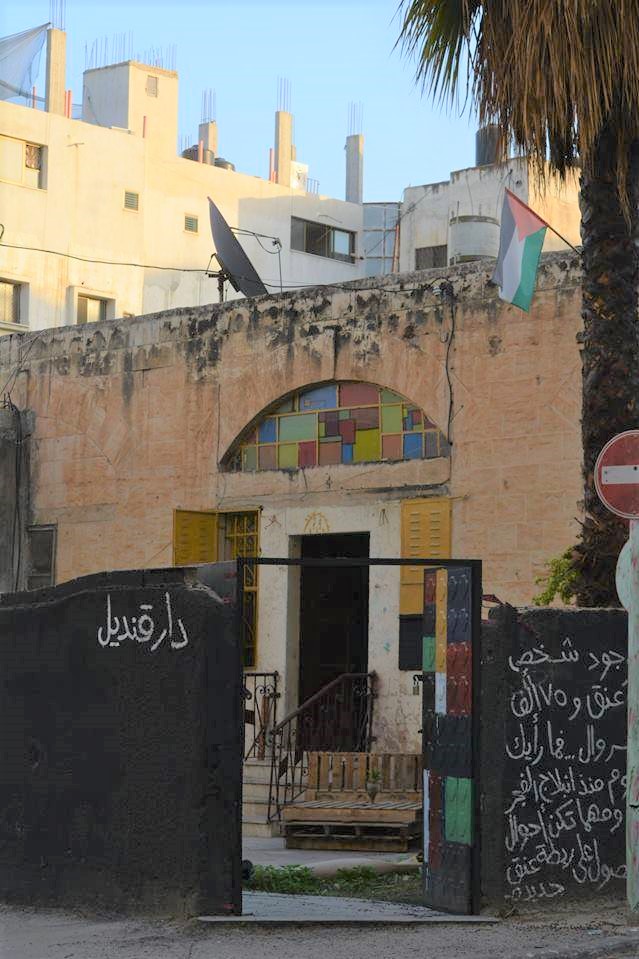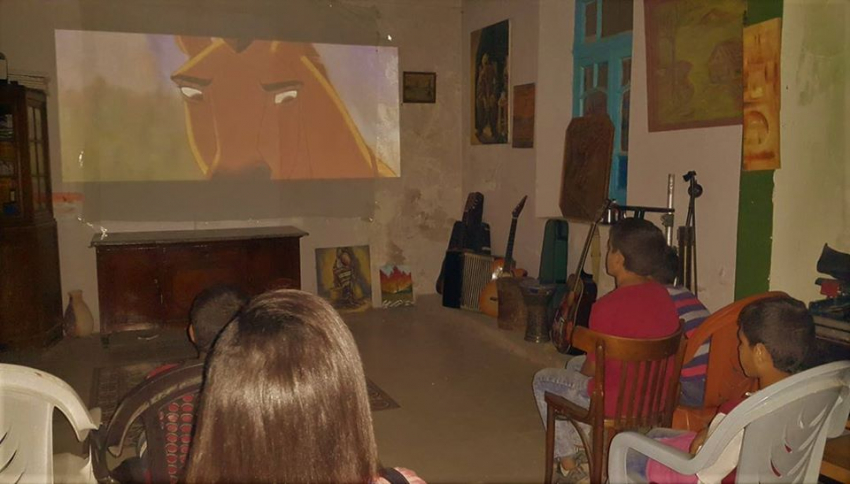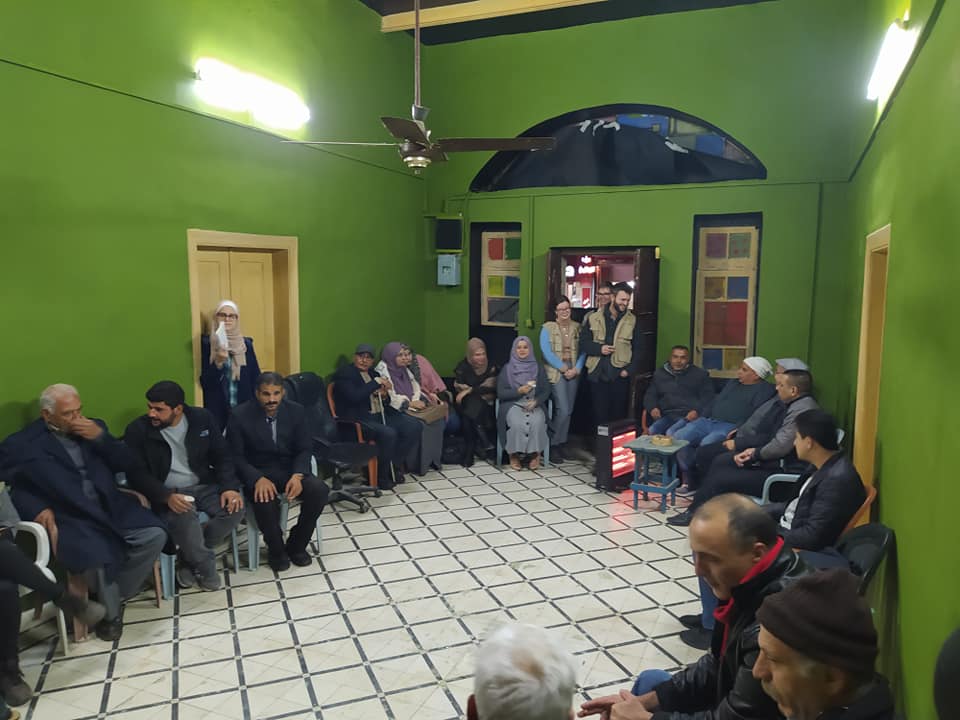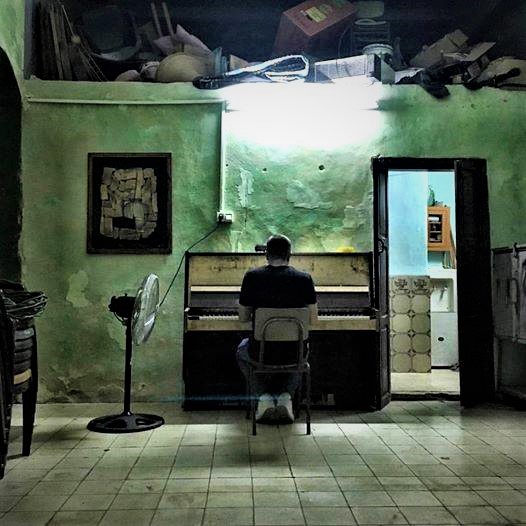

By Tarteel Muammar[1]
From the outset, I knew that writing about Dar Qandeel for Arts and Culture in Tulkarem, a partner of the “Visual Arts: A Flourishing Field” (VAFF) project in its second round, would not be an easy feat and that describing its unique condition would not be like any other. From the first visits to the Dar, we were moved by its effortless familiarity and charm.
First: In the beginning was the place
Although our visit took place in late December 2019, when the Centre was being rehabilitated, power lines were being repaired, and everything was turned upside down because of the maintenance work, the old house, with its small garden, still singularly stood out in the city centre, indifferent to the towering buildings that surround it and block out the sky. The house, safe in its small space, imposes its presence and its tune over the tempo and chaos of the metal workshops, the cars and the market.
This exceptional Centre, unlike any other cultural centre in the area, reflects the essence of the condition it creates. The activities complement the space in creating meaning, and experiencing the space is part of the general building process, evoking memories and patterns of artistic and cultural action that are driven by a desire to change and a dedication to spontaneity and improvisation. The house also stands out in the city because of its old age and its architecture. It holds past narratives, experiences and ideas, and remains a window through which we can look beyond time.
Dar Qandeel shares its thoughts and dreams with us in many ways. It declares them through the songs of the Dar Qandeel band, or expresses them through melodies. The art school of ad-Dar was, and still is, a cornerstone of the Centre’s permanent programmes. In a short space of time, Dar Qandeel has released a collection of albums, such as “Nu’man” and “Why Freedom”, with many other albums and songs that have found their way into Palestinian ears. The band became one of the most famous and widely listened to local musical experiments in the last few years, and has been invited to perform at many national and cultural events. In its live performances, members sing in chorus with the audience, in an attempt to redefine the creative centre of the work, and to propose collaborative effort as a base for producing work. This approach has strengthened the audience’s attachment to these songs, songs that resemble what they like and what they remember.
In addition to music and singing, Dar Qandeel holds theatre workshops and training programmes, bringing together people from nearby areas: from the city, from schools and from refugee camps. This creative culture has turned trainees at Dar Qandeel into initiators of lively discussions and skill-sharing settings, capable of influencing their surroundings.
It is not only about the space, though, as this headquarters is the result of many relocations. It is also about the power of the team and the volunteers over the space, as they utilise it in the service of their beliefs and goals, and about their great ability to add their touch to everything – this is what has really made Dar Qandeel. On my first visit, I was drawn to how involved new employees were, and how within a short period of time they became inseparable from ad-Dar, regardless of how long they’ve been working there or of their social backgrounds.
Sondos Shrim, who joined Dar Qandeel at the beginning of 2020 as an administrative assistant, commented: “It is one family, based on cooperation and appreciation of circumstances. Everyone here, employees, volunteers and visitors, is automatically committed to organised freedom, which makes us different from other regular institutions. This setting leads everyone to do their jobs with loyalty and sincerity, and this is reflected in the increasing numbers of volunteers. And it all boils down to trust. ”
Second: the three conceptual pillars
Volunteers and community work: From its very beginnings, Dar Qandeel was founded by young volunteers. It brought together people from different generations and diverse cultural and academic backgrounds who were actively involved in community work and the arts. The aim was to create an active body capable of influencing – and being influenced by – its surroundings. Until now, the centre has maintained the same spirit – and the team, along with the strategic planning consultant Fadya Salfiti, were keen to take volunteering into account in the developing of ad-Dar’s three-year strategic plan, with the participation of more than 50 volunteers as well as the administrative staff.
In the introduction to the strategic plan, Salfiti mentions the importance of the planning process for Dar Qandeel: “The broad, unconventional and creative approach to building and strengthening the relationship with the community, in addition to focusing on volunteering as an essential value in the life and process of ad-Dar over the last years, has helped its administration to focus its work on the effectiveness and dynamism of a group of volunteers. Dar Qandeel’s volunteers see themselves as an integral part of the Centre, which in many of its activities addresses their individual cultural and artistic and their national desires and aspirations. In turn, Dar Qandeel values its volunteers as its multi-disciplinary cadre who are able to take the experience out to many others.”
This approach is reflected in the general experience of the volunteers, regardless of the activities they take part in. Everyone agrees that Dar Qandeel is their second family, a free space in which they can discover themselves, and through which they can learn and express themselves. Fida Jarad, one of the volunteers, says: “I’ve been a volunteer with ad-Dar since 2009. After I joined one of the summer camps, I stayed on because I felt it was a comfortable, safe and stable space, and because it allows for difference and some release. Dar Qandeel holds you and gives you some solid ground to take off from – first in your heart, and, secondly, out into the world with confidence.”
Rejecting Marginalisation: In addition to being one of the very few artistic cultural institutions operating in the north of the West Bank, and particularly in Tulkarem, understanding the margins and the marginalised was a fundamental point of departure for Dar Qandeel. Later, it strived to reach areas further out from the city centre, presenting and opening its cultural and artistic activities to a wide audience, attracted by unconventional thought, passion and creativity. Over the years, Dar Qandeel has been capable of becoming a renowned and respected institution, fulfilling its cultural and community role. It has also succeeded in drawing attention to many artists and creatives from the region, who have enriched the wider cultural scene in Palestine with their new and innovative production methods.
In order to have a wider and more effective impact, Dar Qandeel has established numerous partnerships and collaborations – with institutions, clubs, centres, libraries and associations within the city, and in Anabta, Deir al-Ghusoon, Nablus and Jenin. The aim is to challenge the marginalisation of the region, and the limited budgets for cultural and artistic action, which as a consuequence have limited official activities.
Third, but not least: the partnership with ad-Dar
At the beginning of December 2019, the A.M. Qattan Foundation signed a contract with Dar Qandeel as part of the second round of the “Visual Arts: A Flourishing Field” (VAFF) project. This partnership has left a unique impact on the project, Yara Odeh, the VAFF Director notes, saying: “The partnership with Dar Qandeel is special and rich. It has involved a lot of learning for the project, because ad-Dar does not follow the regular institutional behaviour VAFF has experienced in its first and current rounds. This caused some hesitation when the jury shortlisted Dar Qandeel for the second round, not because of any doubts about its efficiency and importance, but more because of a fear of affecting its spirit, and of restricting it with bureaucratic procedures. However, this has filled the partnership with caution as well as, at the same time, enthusiasm.”
The partnership supports ad-Dar in establishing the foundations of stability and sustainability in line with the core goals for which it was established. This will be achieved through building a dedicated full-time and part-time team, through developing financial and administrative systems and a strategic action plan for a clear-cut launch following collaborative and high-level research efforts. The aim is to ensure that the outcome responds to Dar Qandeel’s needs and goals, and to cover the administrative, operational and development expenditures, as well as contributing to supporting ad-Dar’s resource development programme.
The grant seeks to support the establishment and implementation of a visual arts programme at Dar Qandeel for Arts and Culture that will include the awarding of 15 production grants for artists. It will also contribute to the capacity building programme for visual artists in the Tulkarem area through organising ten seminars during the project period, setting up four artist residencies, funding a series of technical training workshops in photography, implementing socially engaged art projects, and developing a visual arts educational programme for children.
This partnership is an opportunity to fund the arts in the north of the West Bank and to support this sincere and diligent initiative to transform, and to be transformed by, the wider cultural scene.
Perhaps the group of friends who gathered in the corridor of one Tulkarem’s clinics, where they usually met to complete their theatre training, did not expect that the dream they had carried in a suitcase in 2003 would form the nucleus of Dar Qandeel. Established by the voluntary efforts of active young men and women in the local community, and in response to the lack of spaces for hosting artists and culture enthusiasts, Dar Qandeel began with a collection of papers and a stamp in a suitcase, Alaa Abu Saa, the Director of ad-Dar tells us: “We were driven by a need to express ourselves, with the absence of cultural spaces and infrastructures in Tulkarem. When we realised this need was felt by many others in the north of the West Bank, and that there were many buried and silenced talents and skills, we decided that our future plans would be open to everyone, so we started imagining Dar Qandeel in detail: the studio, the colours, the stage curtains and the garden.”
[1] Assistant Coordinator, “Visual Arts: A Flourishing Field” (VAFF) Project



